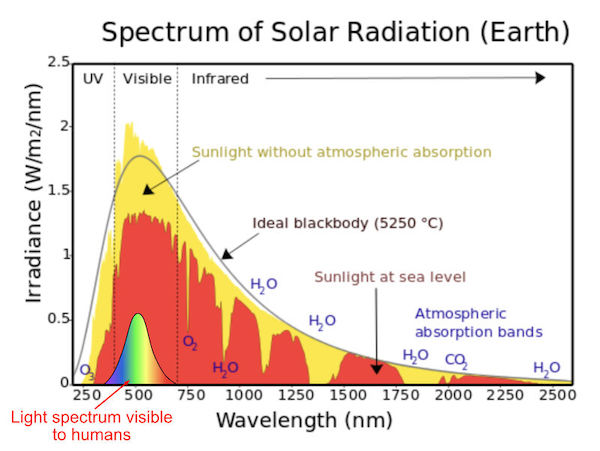
The visible spectrum of a healthy human eye is from 400nm(violet) to 700nm(red). We can’t see wavelengths shorter than 400nm which belong to the so-called ultra-violet range, nor we can see the wavelengths longer than 700nm, which belong to the infra red range.
This is because with thousands years of homo-sapiens evolution, we have developed good vision in the day-time visible spectrum.It is interesting to note that the human eyes are most sensitive to the green colour (around 555nm), which are in the middle of the visible spectrum.
Often people ask: why are our eyes most sensitive to the green wavelengths?
The enclosed illustration explains this very convincingly.
Out of all the sun’s radiation penetrating the earth’s atmosphere the most powerful wavelengths are in the green range.
This also explains the dominant green colour in flora, trees and grass.
Our eye’s retina has three different types of cones, dividing the visible spectrum in three primary colours which our brain mixes them up so that we recognise all colours we can perceive between 400nm and 700nm.
The exact same principle of mixing red, green and blue (RGB) as primary colours is used in electronic cameras and television displays.
Here too, the dominant green component is used as a luminance part of a video signal because of the human sensitivity in this range.
The above is an excerpt from my book “From light to intelligent pixels” which can be ordered from ASIAL at https://asial.com.au/vss.
健康人眼的可见光谱是从400nm(紫色)到700nm(红色)。短于400nm的波长属于所谓的紫外线范围,我们看不见;长于700nm的波长属于红外线范围,我们也看不见。
这是因为经过几千年的人类进化,我们在白天的可见光谱中已经有了很好的视力。
有趣的是,人眼对处于可见光谱中间的绿色(555nm左右)最敏感。
经常有人问:为什么我们的眼睛是最敏感的绿色波长?
所附的插图非常有说服力地解释了这一点。
在所有能穿透地球大气层的太阳辐射中,绿光波长最强。
这也解释了植物、树木和草地的主要颜色是绿色。
我们眼睛的视网膜有三种不同类型的视锥细胞,将可见光谱分为三种原色,我们的大脑将它们混合在一起,使我们能够识别400nm到700nm之间的所有颜色。
将红、绿、蓝(RGB)混合为三原色的原理与电子相机和电视显示器的原理完全相同。
在这里,主要的绿色分量也被用作视频信号的亮度部分,因为人类在这个范围内的敏感性。
以上是我的书“从光到智能像素”的摘录,可以从ASIAL订购https://asial.com.au/vss.


发表评论 取消回复